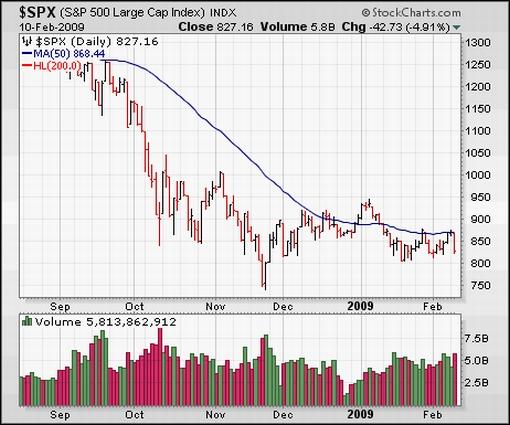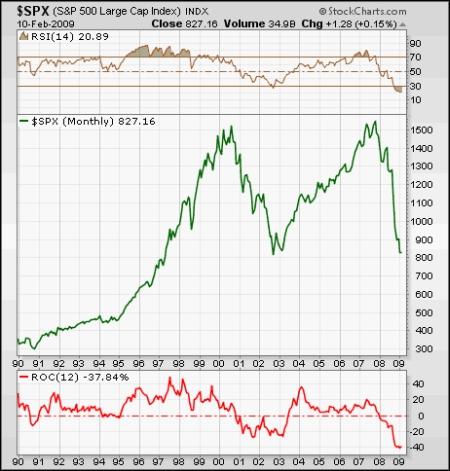Stock Market Sells Off on Disapointing Banking Sector Bailout Plan
Stock-Markets / US Stock Markets Feb 11, 2009 - 06:00 AM GMT

 I am spending the next few days in Europe on a short business trip. First stop is Dublin where the temperature is icy, the mood is dour, property prices are plunging, the queues for jobless claims are five hours long, the soon-to-be-unemployed are holding protest strikes, and the banks are on the edge of a financial precipice. Yes, it may be a movie with different actors, but the plot is the same as in many other countries.
I am spending the next few days in Europe on a short business trip. First stop is Dublin where the temperature is icy, the mood is dour, property prices are plunging, the queues for jobless claims are five hours long, the soon-to-be-unemployed are holding protest strikes, and the banks are on the edge of a financial precipice. Yes, it may be a movie with different actors, but the plot is the same as in many other countries.
Meanwhile in the US, Treasury Secretary Timothy Geithner yesterday disappointed the markets with the lack of detail on the administration's Financial Stability Plan. After all, he did say a few days ago (paraphrasing): ” We are not going to put out the details of our plan until we get it right.” (Please click here for RGE Monitor 's discussion on whether the plan will work.)
The US stock market indices plunged as investors gave a thumbs-down to the announcement, with the S&P 500 Index losing 4.9% and the Dow Jones Industrial Index 4.6%. All market sectors were in the red with Financials (-10.9%) leading the sell-off, with trading volume on the NYSE the highest since mid-December and advances beating declines by seven to one.

According to Lowry 's reports, Friday was a 90% up-day , only to be followed yesterday by a 90% down-day . “Panic on the upside, then panic on the downside - this is one dangerous market,” said venerable Richard Russell ( Dow Theory Letters )..
Bill King ( The King Report ) commented as follows on the bank rescue package: “Geithner and Team Obama have been furiously polling private equity and Street titans to gauge their interest and participation thresholds in various bailout plans. Geithner's lame plan implicitly indicates that few people wanted to participate in the leaked/proposed plans.
“Private investors know toxic paper remains incalculable with open-ended liability. The market understands that no bank bailout has been announced because there is no plan, barring an outright gift, that will fly with private investors. And an outright gift will infuriate taxpayers. Geithner asserted, ‘We will have to try things we've never tried before.' You mean like telling the truth about the quantity and quality of toxic assets?”
Back to the stock market, key resistance and support levels for the major US indices are shown in the table below. All the indices are trading below the 50-day moving averages and the Industrials and Transport have also breached the December 1 lows. The critical November 20 lows are now within close reach and must hold in order to prevent considerable technical damage.

Where to now? As pointed out before, the primary trend is still bearish. The chart below shows the long-term trend of the S&P 500 Index (green line) together with a simple 12-month rate of change (ROC) indicator (red line) and the RSI oscillator (brown line). Although monthly indicators are of little help when it comes to market timing, they do come in handy for defining the primary trend. An ROC line below zero depicts bear trends as experienced in 1990, 1994, 2000 to 2003, and again since December 2007. Having said that, the levels of both the ROC and RSI are massively oversold.

At this juncture, short-term movements are almost impossible to predict, although 90% down-days are usually followed by two- to seven-day bounces. Seven out of the eight most recent 90% down-days were followed by rallies, according to Richard Russell . Having said that, my belief is that traders will simply have to wait for Mr Market to show his hand, especially as far as the November 20 lows are concerned.
And while we wait, I am trying to capture a leprechaun and find the “hidden treasure” on the Emerald Isle.
Did you enjoy this post? If so, click here to subscribe to updates to Investment Postcards from Cape Town by e-mail.
By Dr Prieur du Plessis
Dr Prieur du Plessis is an investment professional with 25 years' experience in investment research and portfolio management.
More than 1200 of his articles on investment-related topics have been published in various regular newspaper, journal and Internet columns (including his blog, Investment Postcards from Cape Town : www.investmentpostcards.com ). He has also published a book, Financial Basics: Investment.
Prieur is chairman and principal shareholder of South African-based Plexus Asset Management , which he founded in 1995. The group conducts investment management, investment consulting, private equity and real estate activities in South Africa and other African countries.
Plexus is the South African partner of John Mauldin , Dallas-based author of the popular Thoughts from the Frontline newsletter, and also has an exclusive licensing agreement with California-based Research Affiliates for managing and distributing its enhanced Fundamental Index™ methodology in the Pan-African area.
Prieur is 53 years old and live with his wife, television producer and presenter Isabel Verwey, and two children in Cape Town , South Africa . His leisure activities include long-distance running, traveling, reading and motor-cycling.
Copyright © 2009 by Prieur du Plessis - All rights reserved.
Disclaimer: The above is a matter of opinion and is not intended as investment advice. Information and analysis above are derived from sources and utilizing methods believed reliable, but we cannot accept responsibility for any trading losses you may incur as a result of this analysis. Do your own due diligence.
Prieur du Plessis Archive |
© 2005-2022 http://www.MarketOracle.co.uk - The Market Oracle is a FREE Daily Financial Markets Analysis & Forecasting online publication.


